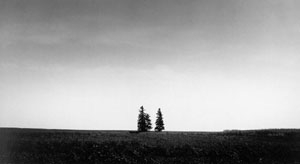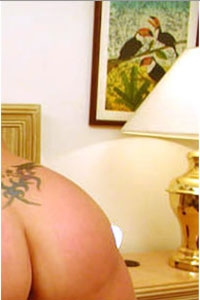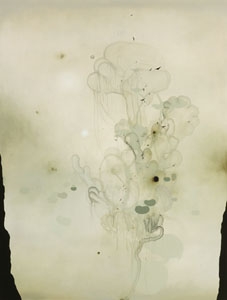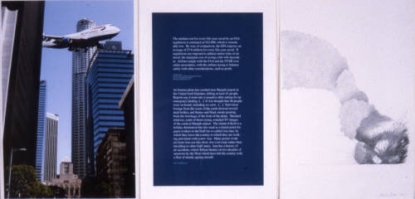Feature: Reviews
Gallery Snapshots
- San Francisco
This is the last weekend to catch shows from a particularly strong group of exhibitions in downtown San Francisco. At Gallery Paule Anglim, John Priola seems to be collapsing Mondrian’s early and late styles together in gelatin silver photographs. In a series called Farm Sites, Priola uses trees, the great subject of Mondrian’s early years, as if they were the perpendicular lines of the Dutchman’s signature style. Choosing the viewpoint where shelterbelts or tree clumps are placed centrally at the horizon, he finds rectitude in organic form —an analog for the organizing influence of agriculture on the landscape. (For more on Priola’s work, see Prajakti Jayavant’s review.)
Across the street at Catharine Clark Gallery, Ray Beldner also emphasizes viewpoint in the digital prints from his Hot series. Beldner isolates bits from commercial images of humans having sex, bringing into focus the art that just happens to be in the room with the coupling bodies. This framing device yields and extraordinarily clever commentary on the relationships between art and pornography, public and private acts, and the marketing of desire.
Also at 49 Geary are Kathryn Van Dyke’s paintings at Stephen Wirtz Gallery and Charles Hobson’s books at Patricia Sweetow Gallery. Van Dyke stretches her material thin, literally, using pallid washes and pencil strokes that barely activate the relatively large canvases. In several works, she pencils irregular triangular forms into a sort of mesh of crumpled space. In Thought Pattern —Geometry’s Ghost (2005), which featured pinpricks of bright color at the junctions of the penciled mesh, Van Dyck successfully maneuvered her timid means into a strong evocation of fragility, instability, and contingency.
Constellations stood out among Hobson’s books, perhaps for no better reason than the spread chosen for display. Die-punched, silver-leafed stars marked out a star formation on a classical figure study. The book looked to offer the considerable pleasures of a kid’s picture book on adult terms, but of necessity, it was inaccessible in a Plexiglass case.
Upstairs in the Haines Gallery, Darren Waterston took his Turning Back In series to the wall, creating a mural that incorporates several of the framed works. One of his recurring forms, a compressed looping line that looks like a cross between ribbon-candy and intestines, floats up the wall in a bubble. The palette of soft, warm greys is so muted that when a red or green passage does appear its impact is noticeably pumped up.
At Toomey-Tourell Gallery, the saturated colors of Xavier Damon’s blown up Polaroid prints promised more oomph than the works deliver. Essentially color-field abstractions, they operated at an awkward, easel-painting scale. Large enough to dissipate any sense of compressed energy but not large enough to diffuse throughout the viewer’s visual field, they hovered in the realm of pretty objects.
In contrast, the narrative triptychs by Charles Gaines at Steven Wolf Fine Arts tackled the stuff everyone is anxious about and no one likes to think about. Each triptych is structured with a photocollage of an airplane flying into an urban space on the left, quoted texts about security, safety, and accidents in the center, and a drawing of smoking rubble on the right. Reading right to left, the panels mirror a mental sequence that seems very familiar: imagining or anticipating disasters; attempting to explain, control, or prevent them; followed by a sense that crashes, in some form, are inevitable. Life leads to death.




